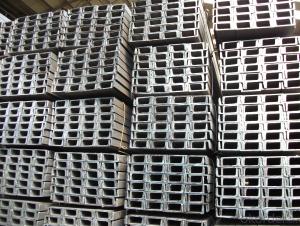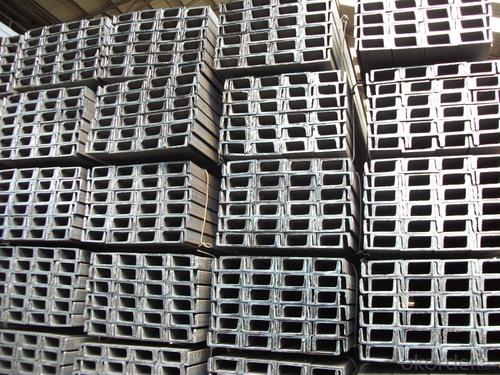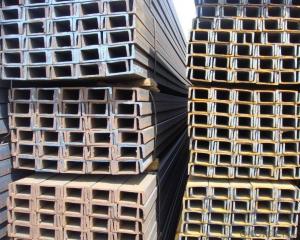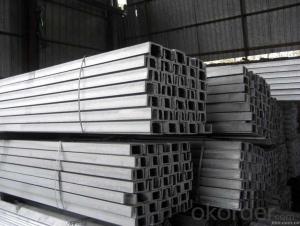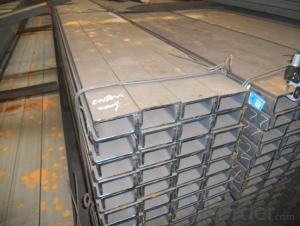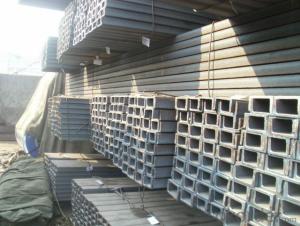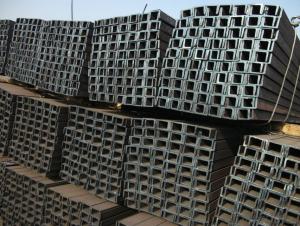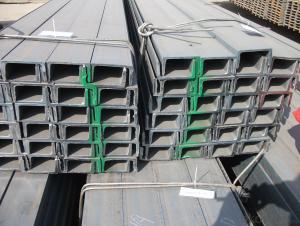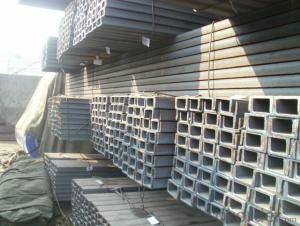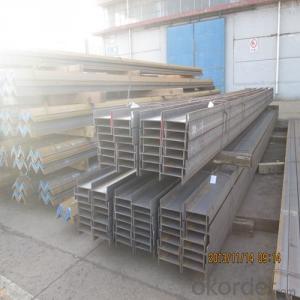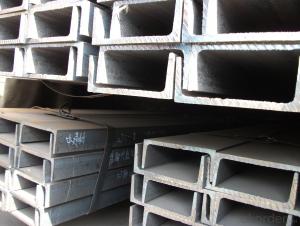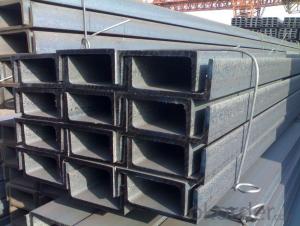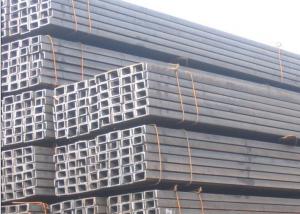HR U Channel Steel with JIS Standard Made in China
- Loading Port:
- Tianjin
- Payment Terms:
- TT or LC
- Min Order Qty:
- 30 m.t.
- Supply Capability:
- 40000 m.t./month
OKorder Service Pledge
OKorder Financial Service
You Might Also Like
Product Description:
OKorder is offering HR U Channel Steel with JIS Standard Made in China at great prices with worldwide shipping. Our supplier is a world-class manufacturer of steel, with our products utilized the world over. OKorder annually supplies products to European, North American and Asian markets. We provide quotations within 24 hours of receiving an inquiry and guarantee competitive prices.
Product Applications:
HR U Channel Steel with JIS Standard Made in China are ideal for structural applications and are widely used in the construction of buildings and bridges, and the manufacturing, petrochemical, and transportation industries.
Product Advantages:
OKorder's HR U Channel Steel with JIS Standard Made in China are durable, strong, and resist corrosion.
Main Product Features:
· Premium quality
· Prompt delivery & seaworthy packing (30 days after receiving deposit)
· Corrosion resistance
· Can be recycled and reused
· Mill test certification
· Professional Service
· Competitive pricing
Packaging & Delivery:
Packaging Detail: products are packed in bundle and then shipped by container or bulk vessel, deformed bar is usually naked strapping delivery, when storing, please pay attention to moisture proof. The performance of rust will produce adverse effect.
Each bundle weight: 2-3MT, or as required
Payment term: TT or L/C
Delivery Detail: within 45 days after received advanced payment or LC.
Label: to be specified by customer, generally, each bundle has 1-2 labels
Trade terms: FOB, CFR, CIF
FAQ:
Q1: Why buy Materials & Equipment from OKorder.com?
A1: All products offered byOKorder.com are carefully selected from China's most reliable manufacturing enterprises. Through its ISO certifications, OKorder.com adheres to the highest standards and a commitment to supply chain safety and customer satisfaction.
Q2: How do we guarantee the quality of our products?
A2: We have established an advanced quality management system which conducts strict quality tests at every step, from raw materials to the final product. At the same time, we provide extensive follow-up service assurances as required.
Q3: How soon can we receive the product after purchase?
A3: Within three days of placing an order, we will begin production. The specific shipping date is dependent upon international and government factors, but is typically 7 to 10 workdays.
Images:
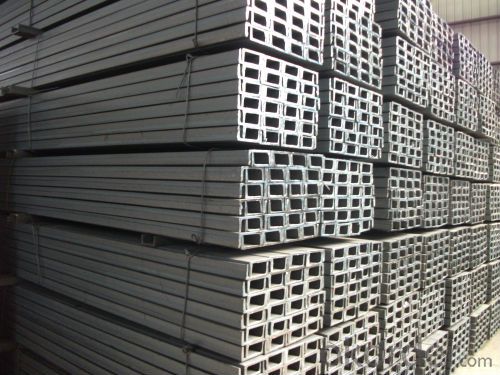
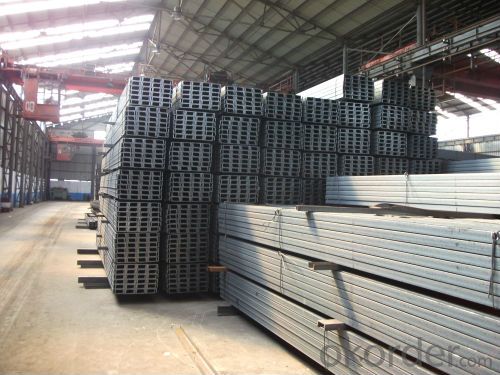
- Q: How do steel channels contribute to structural stability?
- Steel channels contribute to structural stability in several ways. Firstly, they provide added strength and support to the structure. The shape of steel channels, with their wide base and narrow top, allows them to bear heavy loads and resist bending or twisting forces. This makes them ideal for use in beams, columns, and other structural members. Furthermore, steel channels can be used as reinforcement within concrete structures. When embedded in concrete, they enhance the overall strength and durability of the structure. Steel channels help distribute the load across a larger area, reducing stress concentrations and preventing localized failures. In addition, steel channels can be interconnected to form a framework, increasing the rigidity of the structure. By connecting steel channels in a network, they create a system that resists lateral forces such as wind or earthquakes. This helps maintain the stability of the structure and prevents it from collapsing or being damaged during extreme events. Moreover, steel channels are highly resistant to corrosion, which is essential for long-term structural stability. Unlike other materials, steel channels do not deteriorate easily when exposed to moisture, chemicals, or extreme temperatures. This durability ensures that the structural integrity of the building remains intact over time. Overall, steel channels play a vital role in enhancing the structural stability of buildings and other structures. Their strength, versatility, ability to reinforce concrete, and resistance to corrosion make them an indispensable component in construction.
- Q: 120*53*5.5 what's the weight of channel steel?
- Should be the standard channel 12.5X53X5.5D weight is 12.318 kg per meter.
- Q: How do steel channels contribute to the overall stability of a structure?
- Steel channels contribute to the overall stability of a structure in several ways. Firstly, steel channels provide structural support and reinforcement, distributing the load throughout the structure and preventing excessive deflection or deformation. The unique shape of a steel channel, with its flanges and web, offers increased strength and rigidity compared to other structural components. This allows the channels to resist bending, twisting, and buckling forces, ensuring the stability of the structure under various types of loads. Moreover, steel channels are often used as beams or columns, providing vertical support and enhancing the overall stability of a structure. When used as beams, steel channels can span long distances and carry heavy loads, minimizing the need for additional support structures. As columns, steel channels help transfer the vertical loads from the upper levels of the structure to the foundation, maintaining stability and preventing collapse. Additionally, steel channels can be interconnected to form trusses, which are highly efficient in distributing loads and resisting lateral forces such as wind or seismic activity. These trusses effectively transfer the loads to the foundation, ensuring the stability of the entire structure. Furthermore, steel channels can be used in combination with other structural elements, such as steel plates or concrete, to create composite sections that enhance stability and overall structural integrity. In summary, steel channels are crucial components in the construction industry, as they contribute significantly to the overall stability of a structure. Their ability to support heavy loads, resist deformation, and distribute forces efficiently makes them indispensable in ensuring the structural integrity and safety of buildings, bridges, and various other types of infrastructure.
- Q: Do steel channels have any specific safety considerations?
- Indeed, specific safety considerations must be taken into account when dealing with steel channels. These channels are widely utilized in construction and industrial settings to provide structural support, but mishandling them can result in certain safety hazards. One aspect to consider is the weight and dimensions of steel channels. Due to their heaviness and unwieldiness, proper lifting techniques must be employed to prevent strain or harm to workers. Furthermore, caution should be exercised when working in proximity to or underneath steel channels to prevent potential accidents in the event of a fall or collapse. Another safety concern pertains to the sharp edges and corners of steel channels. These sharp surfaces can cause lacerations or punctures if adequate precautions are not taken. To minimize the risk of injury, workers should don appropriate protective gear, including gloves, safety glasses, and steel-toed boots. Additionally, fire safety should not be overlooked when working with steel channels. As steel is an excellent conductor of heat, steel channels can become hot during a fire incident. To minimize the spread of fire through these channels, suitable fire prevention measures and fire-resistant coatings should be implemented. Lastly, ensuring proper installation and maintenance of steel channels is crucial to uphold their structural integrity and safety. Regular inspections should be conducted to identify any signs of corrosion, damage, or fatigue. Promptly addressing any issues can prevent potential structural failures or accidents. In conclusion, although steel channels are known for their durability and widespread use, it is vital to be mindful of the specific safety considerations associated with them. By adhering to proper safety protocols, workers can mitigate risks and maintain a safe working environment.
- Q: How can theoretical weight be obtained for 12.5 channel steel?
- Using 12.6# (126*53*5.5)Weight 12.37 m/kgTheoretical weight of channel steel W=0.00785* waist thickness [height +e (leg width waist thickness)]E value: the general model is 3.26The steel density is 7.85g/cm3
- Q: What are the different types of steel channel connections?
- There are several types of steel channel connections, including bolted connections, welded connections, and riveted connections.
- Q: What are the different industry standards for steel channels?
- There are several industry standards for steel channels, which are used to ensure consistency and quality in the manufacturing and usage of these structural components. Some of the commonly recognized standards for steel channels include: 1. American Standard Channels (C) - These steel channels are defined by the American Iron and Steel Institute (AISI) and are widely used in North America. The dimensions, properties, and tolerances for American Standard Channels are specified in ASTM A6/A6M. 2. European Standard Channels (UPN) - These steel channels are defined by the European Committee for Standardization (CEN) and are prevalent in Europe. The dimensions, properties, and tolerances for European Standard Channels are specified in EN 10365. 3. British Standard Channels (BS) - These steel channels are defined by the British Standards Institution (BSI) and are commonly used in the United Kingdom. The dimensions, properties, and tolerances for British Standard Channels are specified in BS 4-1. 4. Japanese Standard Channels (JIS) - These steel channels are defined by the Japanese Industrial Standards (JIS) and are widely used in Japan and other Asian countries. The dimensions, properties, and tolerances for Japanese Standard Channels are specified in JIS G 3192. 5. Australian/New Zealand Standard Channels (AS/NZS) - These steel channels are defined by the Standards Australia and Standards New Zealand organizations and are commonly used in Australia and New Zealand. The dimensions, properties, and tolerances for Australian/New Zealand Standard Channels are specified in AS/NZS 3679.1. It is important to note that these standards may slightly differ in terms of dimensional tolerances, chemical composition, mechanical properties, and designations. Therefore, understanding and adhering to the appropriate industry standard is crucial for ensuring compatibility and compliance with the specific requirements of a particular project or application involving steel channels.
- Q: Can steel channels be used in railway infrastructure?
- Yes, steel channels can be used in railway infrastructure. Steel channels are commonly used in the construction of railway bridges, tracks, and support structures due to their strength, durability, and ability to withstand heavy loads. They provide structural support and stability, making them ideal for use in railway infrastructure projects.
- Q: Can steel channels be used for roof structures?
- Yes, steel channels can be used for roof structures. Steel channels are commonly used in construction for their strength and durability. They provide structural support and can be used as purlins or rafters in roof systems. Steel channels are able to withstand heavy loads and provide stability to the overall structure. They can also be easily fabricated and installed, making them a popular choice for roof construction. Additionally, steel channels are resistant to fire, corrosion, and pests, making them a reliable and long-lasting option for roof structures.
- Q: How are steel channels protected against corrosion?
- Steel channels can be protected against corrosion through various methods. One common method is the application of a protective coating, such as paint or epoxy, on the surface of the channels. This coating acts as a barrier between the steel and the corrosive elements in the environment, preventing direct contact and reducing the risk of corrosion. Another method is the use of galvanization, which involves coating the steel channels with a layer of zinc. This zinc coating acts as a sacrificial layer, meaning that it corrodes instead of the steel when exposed to corrosive elements. This helps to extend the lifespan of the steel channels and provide long-term protection against corrosion. In addition to protective coatings, steel channels can also be protected through the use of cathodic protection. This involves the application of an electric current to the steel channels, which helps to neutralize the corrosive reactions that lead to corrosion. Cathodic protection is often used in conjunction with other protective measures to provide effective corrosion protection. Regular maintenance and inspection are also crucial in protecting steel channels against corrosion. Any signs of damage or deterioration should be identified and addressed promptly to prevent further corrosion. Cleaning the channels regularly and removing any contaminants or debris can also help to minimize the risk of corrosion. Overall, a combination of protective coatings, galvanization, cathodic protection, and regular maintenance can effectively protect steel channels against corrosion and extend their lifespan.
Send your message to us
HR U Channel Steel with JIS Standard Made in China
- Loading Port:
- Tianjin
- Payment Terms:
- TT or LC
- Min Order Qty:
- 30 m.t.
- Supply Capability:
- 40000 m.t./month
OKorder Service Pledge
OKorder Financial Service
Similar products
Hot products
Hot Searches
Related keywords
